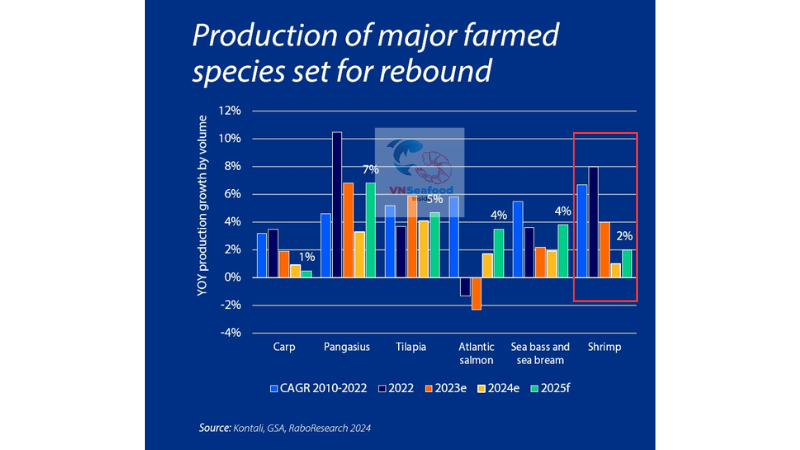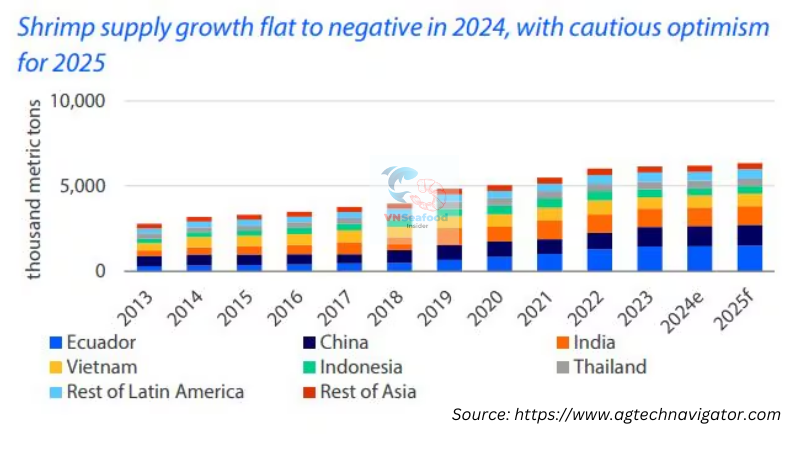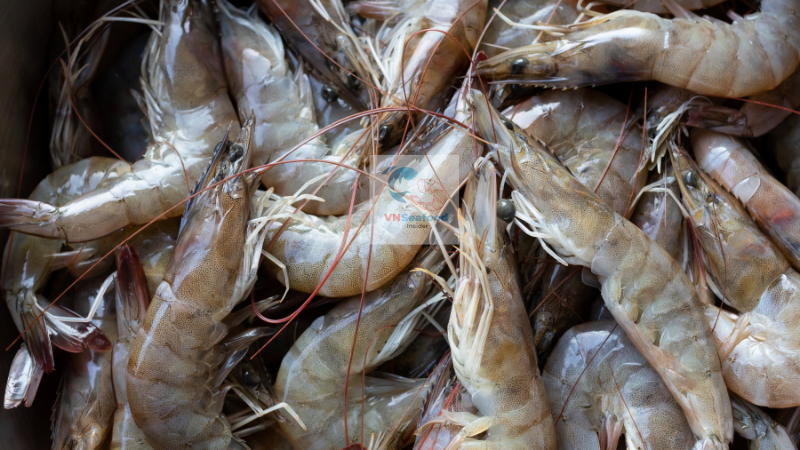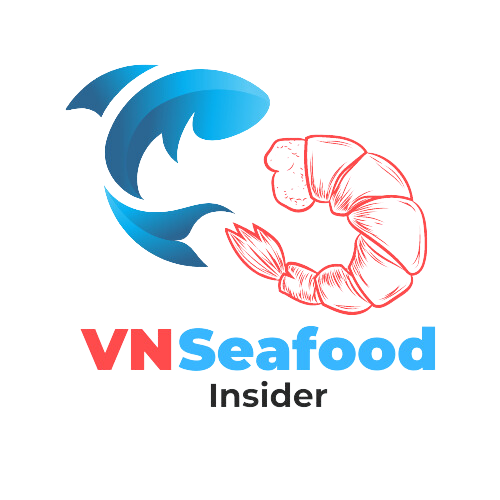In the vast ocean of seafood industries, shrimp continues to reign as one of the most sought-after delicacies worldwide. At VNSeafoodInsider, we’ve been closely monitoring the ebbs and flows of the shrimp market, and we’re excited to share our insights on where this industry is headed by 2025. Whether you’re an investor, processor, exporter, or simply a shrimp enthusiast, understanding the shrimp market trends 2025 will equip you with valuable knowledge to navigate this dynamic sector.
Outline
ToggleThe Current State of Global Shrimp Production
Before we dive into future predictions, let’s take a moment to understand where we stand today. The global shrimp industry has experienced remarkable growth over the past decade, with Asia-Pacific dominating production volumes. Countries like India, Ecuador, Vietnam, and Indonesia have emerged as powerhouses in shrimp farming and export.
Currently, vannamei (white leg) shrimp accounts for approximately 75% of global production, followed by black tiger and other species. This distribution is crucial to understand as we analyze the shrimp market trends 2025 and beyond.
The COVID-19 pandemic delivered a significant blow to the industry, disrupting supply chains and reducing restaurant demand worldwide. However, as we’ve observed at VNSeafoodInsider, the market has shown remarkable resilience, with retail sales picking up some of the slack as home cooking surged during lockdowns. This adaptability gives us confidence as we examine future trends of the growth by 2% in 2025 compared to 2024.

Key Drivers Shaping Shrimp Market Trends 2025
Like a tide influenced by multiple forces, several key factors will shape the shrimp market forecast in the coming years. Understanding these drivers is essential for anyone looking to capitalize on upcoming opportunities.
Sustainable Aquaculture Practices
If there’s one trend that’s making waves across all seafood sectors, it’s sustainability. By 2025, we predict that sustainable shrimp farming will transition from being a competitive advantage to a basic requirement for market access.
“The days of ignoring environmental impacts are behind us,” notes our aquaculture specialist at VNSeafoodInsider. “Consumers and regulators alike are demanding transparency about how shrimp is produced.”
Certification programs like Aquaculture Stewardship Council (ASC), Best Aquaculture Practices (BAP), and organic certifications will gain even more prominence. Farmers who invest in recirculating aquaculture systems (RAS), reduced antibiotic usage, and improved feed conversion ratios will be better positioned to ride the wave of sustainable shrimp production trends.

Technological Innovation in Shrimp Farming
Technology is transforming shrimp farming from an art to a science. By 2025, we expect to see widespread adoption of:
- AI-powered monitoring systems that can predict disease outbreaks before they occur
- Blockchain technology for complete traceability from pond to plate
- Automated feeding systems that optimize growth while minimizing waste
- Genetic advancements for disease-resistant and faster-growing shrimp varieties
These innovations will not only increase productivity but also help address some of the industry’s biggest challenges, including disease management and environmental impact. As we examine shrimp aquaculture trends, it’s clear that technology will be a game-changer for producers willing to invest in these solutions.
Shifting Consumer Preferences
The consumer of 2025 will likely have different priorities than today’s shrimp buyer. Based on current trajectories, we at VNSeafoodInsider anticipate:
- Increased demand for ready-to-cook and value-added shrimp products
- Growing interest in traceable, story-driven shrimp with clear provenance
- Higher willingness to pay premium prices for sustainably farmed shrimp
- Rising consumption in emerging markets as middle classes expand
These evolving preferences will create new market segments and opportunities for innovative products. Producers and exporters who understand these seafood consumption trends will be able to position their offerings accordingly.
See more: How to Source High Quality Shrimp from Vietnamese Shrimp Suppliers -> click here.
Regional Outlook in the Global Shrimp Market 2025
When it comes to the shrimp industry forecast, regional variations paint a fascinating picture of where growth and challenges lie ahead.

Asia-Pacific: Maintaining Dominance with New Challenges
The Asia-Pacific region, currently producing around 75% of global farmed shrimp, will likely maintain its dominant position through 2025. However, several significant shifts are underway:
India’s explosive growth in vannamei production may face limitations due to disease challenges and infrastructure constraints. Meanwhile, Vietnam and Indonesia are investing heavily in sustainable farming practices that could strengthen their market positions. Vietnam with the advantage of favorable tariff with many countries shall be a big player of the world shrimp market.
China presents a particularly interesting case. While remaining a major producer, China’s even more significant role as a consumer will reshape trade flows. As Chinese domestic consumption continues to rise, fewer Chinese shrimp will reach international markets, creating opportunities for other exporting nations. Furthermore, the new tariff policy under Trump’s administration seems to give Chinese shrimp’s producer less advantage in costs compared to other countries.
Latin America: The Rising Star
If you’re watching for rapid growth in the shrimp export market trends, keep your eyes on Latin America. Ecuador has already demonstrated remarkable expansion, increasing exports by double digits annually in recent years. By 2025, we expect:
- Ecuador to potentially challenge India for the title of top global exporter
- Mexico to expand its production capacity significantly
- Brazil to emerge as a more important player in global shrimp trade
The region benefits from excellent natural conditions, improving biosecurity protocols, and proximity to the lucrative North American market. These advantages position Latin American producers to capitalize on the projected growth in shrimp demand trends.
North America and Europe: Premium Markets Evolution
While not major production centers, North America and Europe will continue to shape the industry as premium import markets. By 2025, these regions will likely:
- Implement stricter regulations regarding antibiotic usage and sustainability
- Show increasing preference for certified, traceable shrimp
- Develop more sophisticated market segmentation between commodity and premium shrimp
For exporters targeting these markets, understanding these evolving standards will be crucial to maintaining market access and commanding premium prices.
Challenges on the Horizon for the Shrimp Market
No analysis of shrimp market trends 2025 would be complete without acknowledging the potential storms that may lie ahead. At VNSeafoodInsider, we believe in transparent assessment of both opportunities and challenges.
Disease Management
Disease remains the greatest threat to stable shrimp production. While Early Mortality Syndrome (EMS) has been somewhat contained, new pathogens continue to emerge. White Spot Syndrome Virus (WSSV), Infectious Hypodermal and Hematopoietic Necrosis (IHHN), and other diseases can devastate farms overnight.

By 2025, we expect substantial investments in biosecurity, surveillance, and rapid response systems. Companies developing effective disease prevention solutions will find eager customers throughout the producing regions.
Climate Change Impacts
The shrimp farming industry is particularly vulnerable to climate change effects. Rising sea temperatures, changing salinity levels, and increased frequency of extreme weather events all pose threats to production stability.
“We’re already seeing producers in Vietnam’s Mekong Delta struggling with saltwater intrusion,” observes our climate specialist. “By 2025, adaptation strategies will become essential rather than optional.”
One of shrimp market trends 2025 we can predict that these challenges may accelerate industry consolidation as smaller producers without resources to implement adaptation measures may struggle to maintain viable operations.
Trade Tensions and Regulatory Changes
Geopolitical factors will continue influencing the shrimp trade patterns through 2025. Potential scenarios include:
- Changing import regulations in major markets like the EU, US, and Japan
- New tariff structures affecting competitiveness of various exporting nations
- Evolving standards for antibiotic residues and other food safety parameters
Navigating this complex regulatory environment will require exporters to stay vigilant and adaptable, ready to pivot strategies as conditions change.
Price Trends and Economic Outlook
For many stakeholders, the most pressing question about shrimp market trends 2025 concerns pricing. While crystal ball predictions are notoriously unreliable in commodity markets, several factors suggest a moderately positive outlook:
- Growing global demand, especially from emerging markets, should provide price support
- Improving production efficiencies may help control costs despite inflation pressures
- Premium segments for sustainable, traceable, and value-added products will likely expand
However, price volatility will remain a feature of the industry, with disease outbreaks, weather events, and trade disruptions causing periodic fluctuations. Forward-thinking companies will develop risk management strategies, potentially including futures contracts and diversified sourcing to mitigate these uncertainties.
See another post: Top 6 Vietnam Seafood Export Products 2024 – Market Insights and Trends 2025 -> click here
Strategies for Success in the 2025 Shrimp Market
As we at VNSeafoodInsider look toward the future shrimp industry trends, we see clear strategies emerging for those who wish to thrive in this evolving landscape:

- Invest in sustainability – Beyond mere compliance, leaders will embed sustainability throughout their operations, turning potential regulatory burdens into marketing advantages.
- Embrace technology – From AI-powered disease detection to blockchain traceability, technological adoption will separate industry leaders from laggards.
- Develop value-added products – The days of competing solely on raw commodity pricing are waning. Innovation in processing, packaging, and ready-to-eat formats will unlock higher margins.
- Build strong brands with compelling stories – Consumers increasingly want to know where their food comes from. Companies that can tell authentic stories about their sustainable practices will command premium prices.
- Diversify markets and products – Resilience will come through diversification, both in terms of export destinations and product offerings is the key action of producers toward the shrimp market trends 2025.
Navigating the Tide of Change in Shrimp Market Trends 2025
As we’ve explored throughout this analysis, the shrimp market trends 2025 point toward an industry in transformation. While challenges certainly exist, the overall outlook remains positive for those willing to adapt to changing conditions.

At VNSeafoodInsider, we believe that understanding these trends isn’t just about predicting the future—it’s about helping shape it. By embracing sustainability, innovation, and consumer-centric approaches, the industry can ensure that shrimp remains not only a popular seafood choice but also a responsibly produced one.
Whether you’re a producer looking to maximize returns, an investor seeking opportunities, or simply someone interested in the future of seafood, we hope this analysis has provided valuable insights. The waves of change are coming to the shrimp industry—and with the right knowledge and strategies, you can navigate them successfully.
Are you ready to ride the tide of the evolving shrimp market? We’d love to hear your thoughts and questions about where you see the industry heading by 2025. Connect with us at VNSeafoodInsider for more insights and discussions on the fascinating world of seafood markets.

Pingback: Top 5 Frozen Barramundi Fillet Vietnam Supplier in 2025
Pingback: Vietnam Seafood Export Up 22.3% in 2025 | Import Statistics & Data